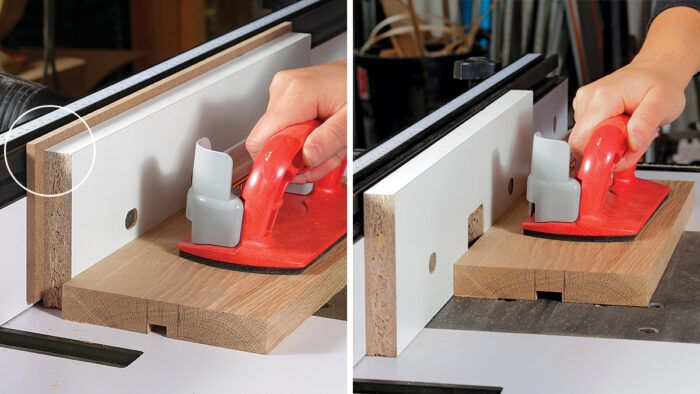Q&A: Router fence spacers
Mike Pekovich answers a reader question about using spacers at the router table.
Tamar Hannah’s Adjustable Router-Table Fence (FWW #292) is interesting and could be a serious time-saver. However, her comment “If you add spacers between passes, you risk a dangerous climb cut, which could yank the workpiece out of your hands and your fingers toward the spinning bit,” doesn’t get that adding a spacer after a pass actually puts the spinning bit deeper under the fence such that there would be no contact. Also the concept that a climb cut is caused not by taking too deep a cut, but by wrongly feeding the work left to right, seems to have been missed.
—Wayne Richard, Seneca, S.C.
Michael Pekovich responds: Sorry for the confusion. You are absolutely correct that the spacers limit the depth of cut when routing a profile along the edge of a board. The advice given here was specific to routing a wide groove in the center of a board. In that case, it is very important that you begin the cut with spacers in place, so that, as you remove them, the bit is cutting the wall farther from the fence as you feed the stock left to right. Should you happen to add a spacer after the first cut, the bit would be cutting along the inside wall of the groove, creating a climb cut since the bit is spinning in the same direction as the feed direction, which is dangerous.
From Fine Woodworking #293
 |
Build an adjustable router-table fenceGet safe, clean cuts on your router table with this shopmade auxiliary fence with removable spacers. |
 |
Router Table Fundamentals- Adjustments |
 |
Build a Router Table |
Fine Woodworking Recommended Products

Grizzly G0495X Industrial Helical Cutterhead 8-in. Jointer

Rockler Dust Right 650 CFM

Rockler Dust Right 1250 CFM























Comments
I think you mean "as you feed the stock right to left" which is the direction shown in the photos.
thank you for that point of clarity because a left to right feed would be a climb cut situation correct?
Can you safely feed stock right to left for a groove in board on the opposite side of the table fence if you were to turn the fence around? I have a situation where I need to cut dovetail sockets for table aprons. In this case the consul table has solid wood slab legs and it would be preferable to use the router table to cut the sockets as opposed to a handheld router.
Any thoughts would be much appreciate.
Thanks
Log in or create an account to post a comment.
Sign up Log in